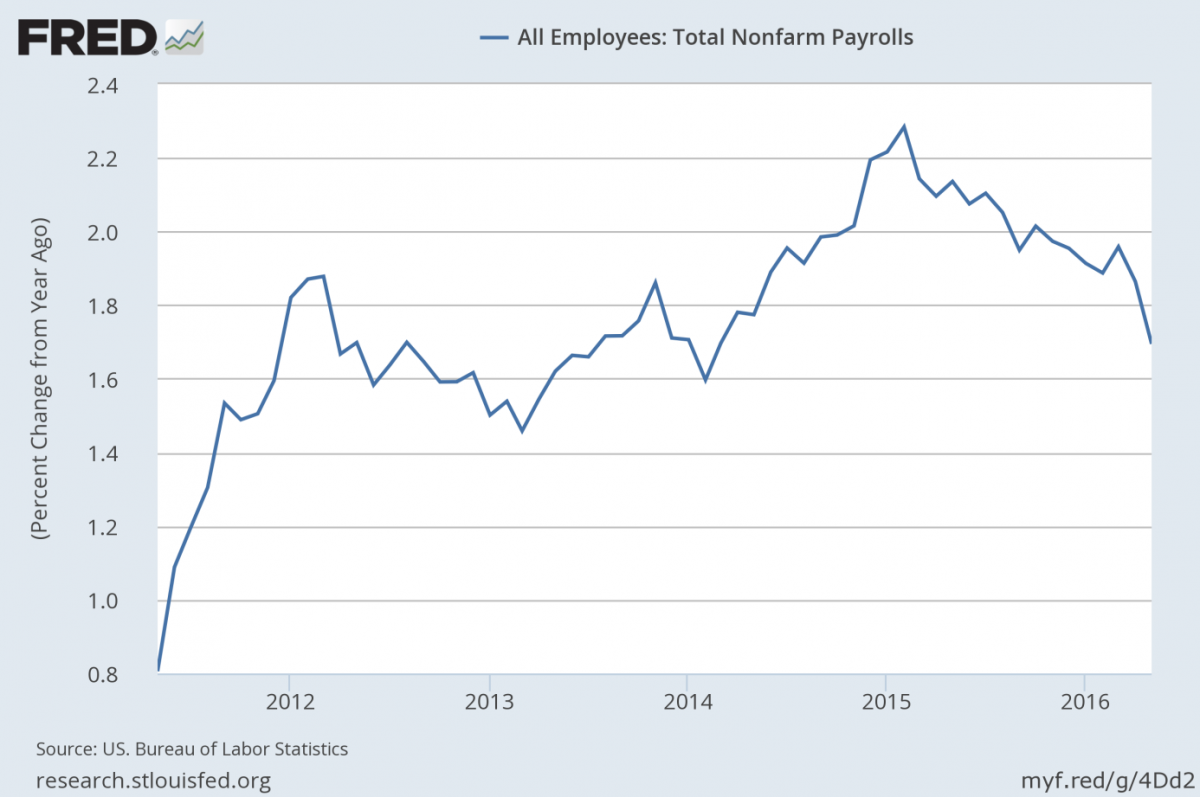May Payrolls Disaster And Gold

The US economy added only 38,000 jobs in May. What does it imply for the Fed policy and the gold market?
Nonfarm Payrolls Are a Nightmare
Total nonfarm payroll employment rose by just 38,000 in May, according to the U.S. Bureau of Labor Statistics. Economists expected 158,000 created jobs. The actual number is thus not just a miss, but a total disaster. Surely, the numbers were partly affected by the Verizon strike which kept about 35,000 employees out of work. However, even taking this one-time factor into account, the report with 73,000 job gains still would be a huge disappointment. The report was really weak – the increase in hiring was the smallest since the fall of 2010. Additionally, the job gains occurred mostly in education and health services, while mining, construction, manufacturing, transportation and warehousing, utilities and information (due to the Verizon strike) all destroyed jobs. Therefore, layoffs were widespread and did not limit to mining. Moreover, the change in total nonfarm payroll employment for March and April combined was revised down by 59,000. It means that the average job gains over the past 3 months were just 116,000. The May number was a catastrophe and it was the second disappointing job report in a row. Actually, on an annual basis, the slowdown in total nonfarm payrolls started in February 2015, as one can see in the chart below.
Chart 1: Total nonfarm payrolls (percent change from a year ago) over the last five years.
Other Labor Market Indicators
Other labor market indicators were not too encouraging either. The unemployment rate dropped from 5 percent to 4.7 percent, but it is not necessarily good news, as the civilian labor force participation decreased by 0.2 percentage point to 62.6 percent. Therefore, fewer people were unemployed because they left the labor market. Probably the only positive thing in the jobs report was that the average hourly earnings increased by 5 cents to $25.59, following an increase of 9 cents in April. The continued positive dynamics should be welcomed by the Fed officials, however, the horrible nonfarm payrolls will overshadow all joy of higher earnings.
Forget About Fed Hike
The terrible jobs report took the June hike off the table. The CME Fedwatch rate hike odds plunged from 20.6 percent to just 3.8 percent. Expectations of the July hike also collapsed. Investors do not see any rate hike until December now. Fed Governor Lael Brainard said after the release of Employment Situation Report that risks may force the Federal Reserve to wait to raise interest rates. Indeed, the nonfarm payrolls may be a game changer for Fed officials who would like to wait and assess once more the U.S. labor market and the overall economy after such a negative shock.
May Payrolls and Gold
On Thursday, we wrote prophetically that “gold should remain under downward pressure until the FOMC meeting unless tomorrow’s nonfarm payrolls are a total disaster”. Indeed, the yellow metal surged after the publication of the jobs report. Gold jumped more than 2 percent from $1,211.50 to almost $1,240 in just two hours. It confirms that the very short-term gold price movement is to a large extent about the expectations of the Fed’s actions (the trends, however, can be in place based on many other reasons as well). If the May jobs report is viewed as a game changer for Fed officials, the gold price could move higher or trade sideways instead of declining. A lot depends now on the Fed officials and how they will interpret and explain the disappointing labor market data. If they try to belittle it and convince investors that nothing really happened and the U.S. economy is in perfect condition justifying a few hikes this year (which is rather unlikely), gold may then find itself under big selling pressure again.
Disclaimer: Please note that the aim of the above analysis is to discuss the likely long-term impact of the featured phenomenon on the price of gold and this analysis does not indicate (nor does it aim to do so) whether gold is likely to move higher or lower in the short- or medium term. In order to determine the latter, many additional factors need to be considered (i.e. sentiment, chart patterns, cycles, indicators, ratios, self-similar patterns and more) and we are taking them into account (and discussing the short- and medium-term outlook) in our trading alerts.



















